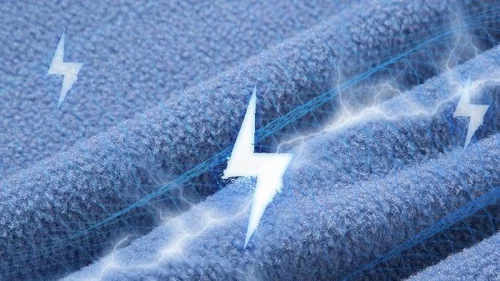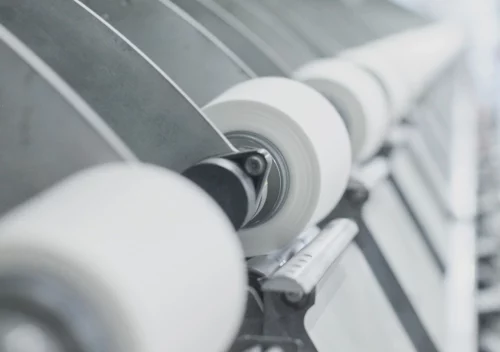Свяжитесь с нами
Спасибо, что обратились! telнам подробнее о ваших потребностях — наша команда экспертов свяжется с вами в течение 24 часов.
Свяжитесь с нами
Спасибо, что обратились! telнам подробнее о ваших потребностях — наша команда экспертов свяжется с вами в течение 24 часов.
Абстрактный. В этой статье в основном обсуждаются принципы и методы изготовления антистатических текстильных материалов, знакомятся с типами и методами производства антистатических волокон, а также с методами производства и стандартами испытаний антистатических тканей. БЕГОДТЕКС предоставляет высокопроизводительное антистатическое пламяогнестойкие ткани, которые широко используются в промышленной защитной одежде и других областях.

Притяжение электронов валентного слоя (известное как электроотрицательность) варьируется в зависимости от атомов, из которых состоят текстильные материалы. Материалы с высокой электроотрицательностью будут притягивать валентные электроны из материалов с низкой электроотрицательностью, чтобы двигаться или перемещаться к ним, в результате чего некоторые материалы несут положительные заряды, а другие - отрицательные. Процесс образования электрического заряда в материале называется электрификацией. Из-за различных условий и окружающей среды заряды на поверхности материалов могут генерироваться или рассеиваться. При достижении равновесия, если материал не является электрически нейтральным, переносимый заряд называется статическим зарядом. Зарядка материалов и возникающее в результате поведение называются электростатическими явлениями.
Во время производства, обработки и использования волокон и изделий из них статическое электричество генерируется из-за таких факторов, как трение, растяжение, сжатие, отслаивание, индукция электрического поля и сушка горячим воздухом.
Статическое электричество, генерируемое одеждой из разных материалов, может привести к тому, что одежда запутается друг в друге, что сделает ее неудобной в ношении. Одежда из химических волокон из-за сильного статического электричества склонна поглощать частицы пыли с разным зарядом из воздуха, которые могут легко загрязнить одежду; Синтетическая одежда также особенно склонна к образованию перхоти. Ношение синтетической одежды создает высокое статическое напряжение из-за трения, которое может разряжаться при прикосновении к проводящим объектам, таким как металл, или рукопожатии с людьми, что приводит к неприятному ощущению поражения электрическим током.
Когда люди носят одежду, которая собирает статические заряды, эти заряды просачиваются через крошечные щели в воздухе, создавая вокруг них искры. Эти искры обладают достаточной энергией, чтобы вызвать или даже спровоцировать взрывы горючих и взрывоопасных газов поблизости. Инциденты, например, когда люди в одежде становятся причиной несчастных случаев, когда взрываются бочки с бензином или возгораются кабинеты эфирной анестезии в больницах; пыль, возгорающаяся на заводах; и статическое электричество, приводящее к отказу парашюта и приводящее к человеческим жертвам.
Влияние электричества на организм человека остается неясным для многих людей. Существуют различные мнения о его эффектах, например, о повышении артериального давления или истощении кальция в кровотоке, что приводит к кожной аллергии. Однако очевидно, что рассмотрение электричества в материалах, используемых для исследования искусственных органов, вызвало значительный интерес из-за его потенциальных последствий для здоровья человека.
Когда волокна в процессе отделения друг от друга расшатываются из-за электричества в среде эксплуатации машин, они неравномерно попадают в станины машин и трубопроводы, среди других участков, что приводит к неравномерной толщине слоя производимого волокна и запутыванию его прижимными роликами. и другие детали машин, что затрудняет бесперебойное производство. На этапе сортировки производства заряженные волокна имеют тенденцию запутываться в компонентах машины, что нарушает производственный процесс и приводит к выбросу пыли из коротких волокон в воздух, что приводит к загрязнению.

Статическое электричество обычно создается двумя способами. За счет контакта и индукции самим существующим статическим электричеством происходит накопление большего статического заряда. Таким образом, антистатика указывает на способность статических материалов уменьшать передачу заряда, что приводит к уменьшению статического образования, сводя к минимуму трение или прикосновение к предметам и, следовательно, обеспечивая антистатический эффект. Обычно используемые методы включают варианты.
Вода превосходно проводит электричество, поскольку, когда волокно или ткань смочены некоторым количеством воды, это позволяет заряду быстро рассеиваться через присутствующую на них воду, тем самым снижая вероятность накопления статического электричества из-за высокой способности волокна поглощать влагу.
Процесс нейтрализации заряда включает в себя смешивание двух веществ с противоположными зарядами на шкале для уравновешивания зарядов различной полярности безtelизбавления от них; вместо этого он сводит на нет поверхностные заряды.
Метод коронного разряда включает в себя перенаправление электричества от тканей без необходимости их заземления за счет использования различных типов проводящих волокон, таких как металлические волокна и волокна на углеродной основе, или нанесения проводящих покрытий, таких как углеродная сажа, на внешний слой синтетических волокон или создания композитного прядения углеродных волокон. соединения на основе металлов или волокнообразующие полимеры для создания композитных волокон проводящего материала.
Методы, обычно используемые в реальном производстве для предотвращения поражения электричеством, в первую очередь включают повышение уровня влажности окружающей среды и повышение проводимости волоконных материалов, при этом фундаментальный подход заключается в снижении сопротивления волокна и повышении проводимости волокна.
Обычно существует три подхода к решению проблемы статики в текстиле. Один из методов предполагает нанесение на ткань статических отделочных средств.
Следующий метод включает в себя усиление волокон путем прививки материалами и объединения их с другими гидрофильными волокнами.
Смешанные или тканые проводящие волокна представляют собой тип материала, используемого в этом контексте. Эти волокна улучшают способность ткани удерживать влагу и способствуют снятию статического электричества.
В настройках или после нескольких стирок в стиральной машине эффект обработки может продлиться недолго или иметь заметный эффект; Третий подход позволяет эффективно и непрерывно решать проблему статического электричества в тканях и подходит для конкретных типов функциональной одежды, например антистатической униформы.

На основе классификации материалов, используемых в волокнах, их можно разделить на антистатические составы, металлические разновидности и антистатические проводящие волокна на основе технического углерода; Примерами также являются проводящие волокна на основе полимеров и антистатические волокна из наноразмерных оксидов металлов.
Процесс включения статических и проводящих волокон в антистатические составы прост и существенно не меняет присущие свойства смолы. Такая интеграция облегчает создание слоя на поверхности материала, который эффективно снижает его поверхностное сопротивление и быстро рассеивает накопленное статическое электричество.
Этот вариант волокна производится путем использования проводимости металлов с использованием таких методов, как метод прямого волочения, который включает в себя многократное протягивание металлической проволоки через форму для ее удлинения. В этом процессе обычно используются такие сплавы, как сталь, медь и алюминий, а также драгоценные металлы, такие как золото и серебро. Другой подход — метод резки, при котором металл разрезается на нити и объединяется с обычными волокнами для создания проводящего текстиля.
Неорганические материалы, такие как углеродная сажа и графен, часто используются из-за их статических и проводящих свойств при производстве проводящих волокон с помощью таких процессов, как применение метода легирования или обработка волокна карбонизацией.
Полимерные материалы обычно рассматриваются как изоляторы; однако появление полиацетиленовых материалов в 1970-х годах поставило под сомнение это представление. С тех пор были обнаружены другие проводящие материалы на основе полимеров, такие как полианилин, что привело к всплеску исследований по изучению проводимости полимерных веществ.
Благодаря световым и прозрачным свойствам порошков оксидов металлов можно создавать антистатические волокна светлого цвета и очень прозрачные на вид. Среди существующих сегодня способов изготовления проводящих волокон этот метод выделяется как модный и полный потенциала.
| Сравнение характеристик проводящих добавок | |
| Виды наполнителей | Основные преимущества и недостатки |
| технический углерод | Дешево и стабильно; Из-за черного цвета продукта, влияющего на его внешний вид, требуется небольшой размер частиц; Высокое удельное сопротивление |
| углеродное волокно | Имеет отличную коррозионную стойкость и радиационную стойкость; Высокая прочность и высокий модуль; Высокое удельное сопротивление и сложная обработка |
| серебро | Стабильные свойства и низкое удельное сопротивление; Дорогая цена и проблема миграции серебра |
| Усы оксида цинка | Низкая дозировка, хорошая стабильность и светлый цвет; Высокое удельное сопротивление |
| Титания | Хорошая стабильность и светлый цвет; Высокое удельное сопротивление |
| Нанодиоксид олова (легированный сурьмой) | Хорошая стабильность, светлый цвет, небольшой размер частиц, высокая прозрачность. |
Антистатические волокна можно производить с использованием двух производственных технологий, которые предполагают использование антистатических веществ для классификации волокон. Внешний антистатический метод и внутренний антистатический метод.
Подход к внешней антистатике включает нанесение антистатического агента на поверхности волокон, известный как метод отделки поверхности, который можно разделить на временные и долговечные методы антистатической отделки.
Реализация метода предотвращения статического электричества включает добавление антистатического агента внутрь волокна.
В большинстве случаев химические реакции используются для модификации текстильных волокон с целью получения статических волокон. Первый метод включает в себя химические изменения для создания статических волокон, тогда как второй метод включает в себя методы смешивания или композитные материалы для той же цели.
В 1960-х годах были представлены проводящие волокна. Сначала в виде органических проводящих волокон, покрытых сажей, а затем в виде волокон, покрытых металлом на поверхности. Механические характеристики этих металлизированных волокон заметно отличаются от обычных волокон, что усложняет их смешивание и объясняет, почему они не используются широко.

Антистатический текстиль должен соответствовать стандартам статической функциональности, а также соответствовать внешнему виду и характеристикам, типичным для обычных материалов для одежды. Этот антистатический текстиль обычно используется в условиях, требующих антистатических свойств, таких как аэрокосмическая деятельность или такие отрасли, как оборонная добыча нефти, горнодобывающая промышленность и здравоохранение. Они обычно используются в качестве предметов в повседневной жизни. В результате в структуре текстильного дизайна приоритет должен отдаваться более плотным тканям.
Использование создания антистатической ткани в качестве примера для иллюстрации процесса производства антистатической ткани.
Процесс создания статического акрилового волокна обычно включает в себя модификацию акрилового волокна, чтобы сделать его антистатичным с помощью различных методов, таких как обработка поверхности волокна и смешивание с другими материалами или химикатами, например, формование композита и добавление проводящих материалов для наполнителей.
При обработке волокон для уменьшения накопления электричества в поверхностном слое обычно используются проводящие соли металлов или поверхностно-активные вещества, известные как антистатики, с помощью таких методов, как распыление или покрытие волокон и их тканей.
Путем включения некоторого количества проводящего материала, такого как углеродная сажа или оксид металла, в акриловое волокно и смешивания его с раствором акрилового волокна получается долговечное антистатическое акриловое волокно. Это конкретное антистатическое волокно демонстрирует длительное статическое воздействие; однако добавленный антистатический агент должен обладать особыми характеристиками термостабильности и быть совместимым с волокном во время обработки.
Включение мономеров в процесс производства акрилового сополимерного материала и участие в реакциях сополимеризации для создания гидрофильных акриловых волокон повышают способность впитывания влаги конечного продукта и придают антистатические свойства акриловым волокнам.
Проводящие элементы внутри проводящих волокон, изготовленных методом формования композита, непрерывно перемещаются в продольном направлении и легко высвобождают накопленные заряды. Различные составные конфигурации состоят из конструкций сердцевины обшивки. Одно- или многоточечные круглые конструкции, а также сэндвич-формы.
В процессе прядения проводящий внутренний слой состоит из проводящих материалов и волокон для повышения проводимости, которые специально добавляются в раствор для прядения волокнаtelот самого процесса прядения композита.

Испытание электричества включает в себя изучение различных аспектов, таких как выявление потенциальных источников опасности статического электричества и оценка свойств статического электричества материалов и продуктов, а также оценка чувствительности легковоспламеняющихся и взрывоопасных материалов к воздействию статического электричества. Стандарты, регулирующие свойства текстиля, включают в себя такие руководящие принципы, как серия GB/T 12703 и FZ/T 01059, среди других.
Методы тестирования электрического заряда волокон или тканей можно условно разделить на две категории: качественный анализ и количественный анализ. При качественном анализе можно наблюдать наличие искр разряда, поражения электрическим током, звуков разряда, а также притяжение (прилипание пыли, загрязнение и обвитие вокруг тела).
Основные методы испытаний включают в себя: метод периода полураспада статического напряжения, метод фрикционного заряженного напряжения, метод поверхностной плотности заряда, метод динамического статического напряжения, метод количества заряда и метод удельного сопротивления.
Ткани BEGOODTEX обладают статическими свойствами, которые достигаются с помощью специальных технологий, адаптированных для текстиля, для предотвращения накопления статического электричества за счет включения проводящих волокон или нанесения антистатический лечение. Такой подход помогает разрядить заряды и свести к минимуму вероятность возникновения искр, которые могут вызвать срабатывание легковоспламеняющихся материалов или повредить чувствительные электронные детали.
Огнестойкие ткани BEGOODTEX не только обладают антистатическими свойствами, но и подвергаются обработке современными огнезащитными химическими веществами для эффективного соответствия нормам безопасности. Это предполагает нанесение стойких антипиренов на хлопковые волокна и ткани, из которых они вплетены, обеспечивающие сохранение огнестойкости примерноtel50 стирок.
Огнестойкие и антистатические свойства тканей BEGOODTEX делают их идеальными для таких целей, какзащитная спецодежда в отраслях, где риск пожара и статическое электричество вызывают серьезные опасения. Этот универсальный текстиль обеспечивает безопасность работников и играет решающую роль в соблюдении стандартов безопасности на рабочем месте.